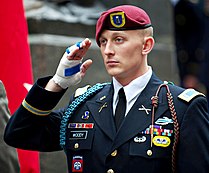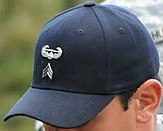Uniforms of the United States Army
Theuniforms of the United States Armydistinguish soldiers from other service members.U.S. Armyuniform designs have historically been influenced by British and French military traditions, as well as contemporary U.S. civilian fashion trends. The two primary uniforms of the modern U.S. Army are theArmy Combat Uniform,used in operational environments, and theArmy Green Service Uniform,worn during everyday professional wear and during formal and ceremonial occasions that do not warrant the wear of the more formal blue service uniform.
History
[edit]
The design of early army uniforms was influenced by both British and French traditions. One of the first Army-wide regulations, adopted in 1789, prescribed blue coats with colored facings to identify a unit's region of origin: New England units wore white facings, southern units wore blue facings, and units from Mid-Atlantic states wore red facings.[1]Bandsmen wore red uniforms to make them more easily identifiable to commanders on the field of battle. Pantaloons were originally white, following British uniforms, but were changed to gray in 1821 and sky blue in 1832. Infantry wore tricorne hats, with different cover prescribed for cavalry and specialist troops depending on function.
The originalRevolutionary Warenlisted uniform jacket was dark blue with state-specific facing colors. This was worn with a whitewaistcoatandbreechesand black shoes. All ranks wore a blacktricornehat with a blackcockade;later a white cockade was inset to represent the American alliance with Bourbon France. From 1782, Regulars had redfacings.Foot regiments (infantry, artillery, and supporting units) wore gold-metal buttons and lace. Horse regiments (cavalry, light dragoons, and horse artillery) wore white-metal buttons and lace.
From 1810, the uniform changed to follow European trends. The tight-fitting and short-skirted double-breastedcoateereplaced the single-breasted coat, and the waistcoat was discontinued. Militia wore gray coatees, still worn as a ceremonial uniform atWest Pointtoday. Regulars wore national blue (dark-blue) coatees, except for musicians, who wore reversed red coatees with blue facings. Enlisted ranks wore the coatee with a black stovepipe shako, white or gray trousers with matching button-upspats,and black short boots.[2]
Facings and buttonhole trim were discontinued in 1813. From the early days of the Continental Army, the wearing of aswordand a worsted crimsonsashserved as a badge of rank for all sergeant grades. By 1820, the worsted sash became a privilege of first sergeants and above only. From 1781, until 1833, the "first sergeant" was simply the senior sergeant in a company or battery and was not a separate grade of rank.[3]
Beginning in the 1850s, U.S. military leadership began to place an increased emphasis on French army tactics and styles, influenced, in part, by the rise ofNapoleon III.[4]The most extreme adoption of French military fashion was in the use ofzouaveuniforms by some U.S. Army infantry regiments, and the purchase of 10,000chasseurs à pieduniforms to outfit theExcelsior Brigade.[5]More subtle French styling – including frock coats, kepi hats, and collar ornaments – were more common foruniforms of the Union Armyduring and after theAmerican Civil War.


Beginning in 1902, the Army made khaki and olive drab field uniforms standard issue, having seen their effectiveness in limited use during theSpanish–American War.The traditional blue was reserved for dress uniforms. Uniforms used duringWorld War Iremained substantially similar to the 1902 patterns. Blue uniforms were suspended during the conflict. During the inter-war period, piecemeal modifications were made to the designs, such as the introduction of open-collar coats, straight-legged trousers, and collared shirts with ties, resulting in uniforms that by the end of the 1930s were entirely different. A blue dress uniform was reintroduced in 1937.
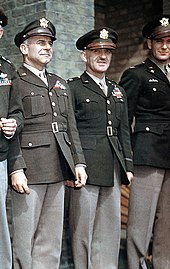
TheU.S. Army uniforms used during World War IIsaw a divergence between field and garrison service elements. The latter necessitated by the suspension of the blue dress uniform again, leading to them becoming separate classes of uniforms by the end of the war. These uniforms continued in use into the Korean War.
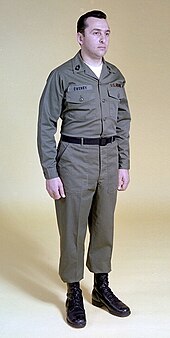
TheOG-107combat uniform was introduced as the new standard field uniform during theKorean War,and continued as the standard fatigue duty uniform for almost three decades. It saw minor changes through its lifespan.

In 1954, the Army Green Uniform, also called the "Class A" uniform, was introduced for garrison dress.[6]An alternate semi-dress uniform for the summer months, the Army Tan Uniform, continued in use until 1985, though was relegated to Class B status following the mid 1960s. The blue dress uniform, now mandatory for officers and an authorized option for enlisted soldiers, was reinstated in 1957.
The OG-107 field uniform was replaced in 1981 by theBattle Dress UniformandDesert Battle Dress Uniform,later theDesert Camouflage Uniform,which saw use during theGulf War.These were replaced by theArmy Combat Uniform(ACU) in the mid-2000s, during the War in Afghanistan and War in Iraq. When initially introduced, the ACU used theUniversal Camouflage Pattern.This proved to be an ineffective pattern and was replaced beginning in 2014 with the more effectiveOperational Camouflage Pattern.As of 2021[update],the ACU in OCP is the standard issue field uniform of the Army.
Beginning in 2010, the blueArmy Service Uniform(ASU),[7]previously used as a formal dress uniform, displaced the green Class A uniform as the daily wear service uniform. This move proved unpopular, and in 2018 a new Army Green Service Uniform (AGSU) modeled after World War II-era officers garrison uniforms was announced. By October 1, 2027, all soldiers will be required to wear the AGSU as office attire. The blue uniform will remain the ceremonial and formal dress uniform.[8]
Current designs
[edit]Standard uniforms
[edit]Combat uniform
[edit]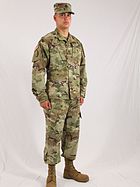
TheArmy Combat Uniform(ACU) is the utility uniform worn ingarrisonand incombatzones by the U.S. Army. It consists of a jacket and trousers in theOperational Camouflage Pattern(OCP), worn with combat boots and a t-shirt. In the field, the jacket may be replaced by the flame resistantArmy Combat Shirtwhen worn directly under a tactical vest. A matching patrol cap is worn when other headgear is not in use.
The ACU was introduced in 2005, replacing the previousBattle Dress UniformandDesert Camouflage Uniform.The uniform originally featured a pixelated camouflage pattern, known as theUniversal Camouflage Pattern(UCP), which was designed for use in woodland, desert, and urban environments, and was worn with a black beret.[9]The black beret was replaced for wear with the ACU by the patrol cap in July 2011; the beret remained in use with the Army Service Uniform. UCP was found to perform poorly in the field, and beginning in 2010, most soldiers operating in Afghanistan were issued ACUs using the commercialMultiCampattern, which was found to be better suited to that country's terrain.[10]Subsequently, OCP, which is similar to MultiCam, was adopted Army-wide starting in 2015, with UCP fully retired in 2019.
The ACU jacket bears name tapes, rank insignia, and shoulder patches and tabs, as well as recognition devices such as a U.S. flag patch and the infrared (IR) tab. Two U.S. flag insignia are authorized for wear with the ACU, full-color and subdued IR. The U.S. flag insignia is worn on the right shoulder pocket flap of the ACU coat. Unit patches are worn on the left shoulder, while combat patches are worn on the right. The name tapes, rank, and skill badges are either secured withhook-and-loop fastenersor can optionally be sewn on.
Service uniform
[edit]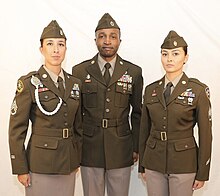
The current garrison service uniform is known as theArmy Green Service Uniform.[11]Introduced in late 2018, it is based on the "pinks and greens"officers' service uniform worn in World War II and the Korean War.[8][12]The service uniform includes a darkolive drabcoat, lightdrabtrousers, atanshirt, an olive drab tie, and brown leather shoes for both men and women, with women having the option to wear a pencil skirt and pumps instead.[13]The uniform became available to soldiers in mid-2020.[14]

From 2010 to 2020, a blue uniform, known as theArmy Blue Service Uniform,was used as the daily wear service uniform. The Army has a tradition of blue uniforms dating to the Revolutionary War, and the blue uniform returns to its previous position as a formal dress and ceremonial uniform. It had replaced in daily wear the previous green service uniform used by all officers and enlisted personnel introduced in 1956.[15][16]
Mess uniform
[edit]
Mess dress is the military term for the formal evening dress worn in the mess or at other formal occasions. This is generally worn as the military equivalent ofwhite tieorblack tie.The Army has two versions, a blue winter version and a white summer version, each worn with different accessories depending on the formality of the occasion.
The blue mess uniform comprises the Army blue mess jacket, high-waisted trousers, white semiformal dress shirt with a turndown collar, black bow tie, and black cummerbund. The blue trousers are cut along the lines of civilian dress trousers, with a high waist and without pleats, cuffs, or hip pockets. The trouser leg ornamentation consists of an ornamental braid worn on the outside seam of the trouser leg, from the bottom of the waistband to the bottom of the trouser leg.
General officers wear pants of the same color as the jacket, with two ½–inch, gold-colored braids, spaced ½ inch apart. Current stated uniform regulation for mess dress is that all other officers and enlisted personnel wear lighter blue trousers with a single 1 ½ inch, gold-colored braid. When worn for white tie events, it is worn with a white formal dress shirt with a wing collar, white waistcoat, and white bow tie instead of the black tie versions.
The white mess uniform is similar, but features a white mess jacket and black high-waisted trousers instead. The trousers are the same for all ranks.
Physical training uniform
[edit]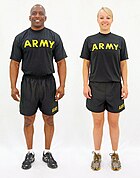
The Army Physical Fitness Uniform (APFU), manufactured byUNICORand adopted in 2013, is modular, with individual pieces that can be combined or eliminated depending on physical training conditions. All parts of the uniform are styled in black and gold and include track jacket, short-sleeve and long-sleeve T-shirts, track pants, and stretchable running trunks. The uniform was released in October 2014. No standard shoe style is specified to be worn. Soldiers are expected simply to purchase commercial running shoes. Shoes with profane or vulgar logos, as well as "toe shoes", such as the Vibram FiveFingers running shoe, are prohibited.[17]
Special ceremonial units
[edit]U.S. Army uniform regulations define a class of "special ceremonial units" (SCUs), which include guards units and bands, that are authorized to wear distinctive uniforms – in lieu of the Army Service Uniform – for public duties, including state arrivals, official funerals, change-of-command and retirement ceremonies, and the presidential inaugural parade.
-
Uniform of a drummer in theOld Guard Fife and Drum Corps (3rd US Infantry Regiment)
-
Uniform of a drum major in the Old Guard Fife and Drum Corps
-
Uniform of a sergeant in theCommander-in-Chief's Guard
-
Uniform of a drum major in theWest Point Band
-
Uniform of a corporal in theFirst Troop Philadelphia City Cavalry
-
Uniform of a sergeant in the1st Cavalry Division Horse Cavalry Detachment
-
Uniform of a U.S. Army Herald Trumpeter
-
Uniform of a U.S. Army Special Bandsman
-
Uniform of a U.S. Army Special Band drum major
Bands
[edit]The U.S. Army has 34 active-duty bands and more than 50 reserve bands. Most of these units wear the Army Service Uniform forpublic duties;however, certain units – primarily located in theNational Capital Region– have unit-specific uniforms that are used for special occasions. Unlike the Army Service Uniform, these specialized uniforms are, for budgetary reasons, generally issued to units – instead of individuals – and returned to the unit following the soldier's departure.
TheU.S. Army Band"Pershing's Own", the U.S. Army Field Band, and the U.S. Army Herald Trumpets wear a parade uniform designed by theU.S. Army Institute of Heraldryand introduced in 1969 for the inauguration ofRichard Nixon.The uniform blouse has a choker-style collar, instead of the open collar used on the Army Service Uniform, and eight buttons, representing the eight notes of the musical scale. Decorative gold braid adorns the cuffs and standard army cover is replaced by a crimsonpeaked hat,while drum majors wear a bearskin helmet. A summer white blouse is also available.[18]In the 1950s "Pershing's Own" briefly wore a yellow and black uniform known as "the Lion Tamer" due to its resemblance to a circus costume. BeforeWorld War II,the band's uniform was a grey variation of the standard dress blue uniform.
The 3rd Infantry Regiment Fife and Drum Corps wear red, open-front regimental coats, white coveralls, and black tri-corner hats.
The U.S. Military Academy Band – a full-time band assigned to the U.S. Military Academy at West Point - wears distinctive, high-collared navy jackets with white accessories and dark shakos. From 1875 to 1890 the band worepickelhaubeinstead of shakos.
Guards
[edit]The Commander-in-Chief's Guard, part of the 3rd Infantry Regiment, uses a special dress uniform that is evocative of the uniform worn by Gen. George Washington's life guard. It consists of open-front, blue regimental coats, white coveralls, and black tricorner hats.
TheFirst Troop Philadelphia City Cavalry(a Pennsylvania National Guard unit) has a special full-dress uniform known for its distinctive helmet with extravagant bearskin roach.[19]
The 1st Cavalry Division's Horse Detachment was given status as a Special Ceremonial Unit in 1972. Their parade uniform consists of a navy "fireman's shirt", worn with Columbia blue trousers with yellow piping. Accoutrements include a divisionalkerchiefworn around the neck and yellow suspenders. Cover is theCavalry Stetson.
Other non-band SCU units with distinctive uniforms include 54th Massachusetts Volunteer Infantry.
Cadet uniforms
[edit]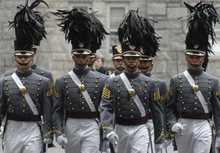
West Point
[edit]Cadets enrolled at theUnited States Military Academyat West Point wear standard Army uniforms, including the Army Combat Uniform and the Army Physical Fitness Uniform, but also use several unique uniforms for drills and daily wear in lieu of the Army Service Uniform. Since 1816, West Point cadet uniforms have been styled incadet greywhich continues to be the primary color used in academy dress.
Spring parade dress consists of cadet grey swallow-tail coats with 21-gold buttons, a standing collar, white trousers, and black shakos (known as a "tarbucket hat" in U.S. Army nomenclature). Winter parade dress is similar to spring parade dress, though trousers are colored cadet gray instead of white. This same uniform is worn without the black shakos hat and with the gray or white peaked service cap depending on the season when not parading but still required for formal events. For evening formal events, no headgear is worn.[20]
Summer dress ( "India Whites" ) consist of a white overblouse with a standing collar, white trousers and white peaked service caps. Service dress ( “white over gray” ) consists of grey trousers, short sleeve white shirts with shoulder boards, and white peaked caps. "Dress Gray" uniforms consist of gray blouses with a standing collar and trimmed with a one-inch black mohair braid band, gray trousers and gray peaked caps. In cold weather, a gray Long Overcoat is worn over the uniform. The daily service uniform ( "As for Class" ) consists of gray trousers, charcoal gray shirts in long sleeve and short sleeve variants and garrison caps.[21]
Senior military colleges
[edit]
Cadets atsenior military collegesare authorized, under Army Regulation 670–1, to wear uniforms developed by their institutions. Regular U.S. Army personnel assigned to those units as instructors may also wear institutionally developed uniforms in lieu of standard army dress.[citation needed]Most corps of cadets at senior military colleges wear uniforms loosely patterned on that of the U.S. Military Academy at West Point. One exception isTexas A&M Universitywhich has several styles of cadet dress uniforms modeled after Army officers uniforms of World War II. The corps' special ceremonial unit, the Ross Volunteers, wear an all-white parade uniform with peaked hat, and theFish Drill Team,the corps' all-freshman rifle drill squad, wears the "Midnight" uniform with black "paratrooper" boots, white belts, and black polished combat helmet with chromed brass.[22]
ROTC and Junior ROTC units
[edit]Reserve Officer Training Corps(ROTC) and Junior ROTC (JROTC) cadets wear the Army Service Uniform, the Army Combat Uniform and the Physical Training Uniform with some differences in rank, insignia and headgear for the JROTC cadet ASU. Junior ROTC cadets wear grey shirts instead of white shirts and grey berets instead of black berets with their Army service uniform.
Special uniform situations
[edit]Special covers
[edit]Soldiers assigned to the cavalry units may, during certain divisional functions, replace standard army soft cover (the black beret, the blue peaked hat, or the camouflage patrol cap) with the “Cav Stetson,” a blackStetsonwith yellow braid (gold for officers) and cavalry branch insignia.[23]
U.S. ArmyDrill Sergeantsare authorized to wear acampaign hatwhile in the Army Combat Uniform. First adopted in 1911, the campaign hat was abandoned for drill instructor use during World War II, but readopted in 1964. Army campaign hats are olive green with theGreat Seal of the United Statescentered on the front of the hat on a gold disc.
Several beretsin alternate colors to the Army standardblack beretare also used. Personnel assigned to units trained and equipped for parachute infiltration, known asairborne forces—such as the82nd Airborne Division—are authorized to wear amaroon beretwhile soldiers assigned to the75th Ranger Regimentweartan berets.Soldiers who graduate from theSpecial ForcesQualification Courseare authorized to wear agreen beret.The Army's newest units, theSecurity Force Assistance Brigades(SFABs), are authorized to wear a dark brown beret.
The U.S. Army has also authorized the wear of distinctive baseball-style caps for some personnel. Special skill instructors are authorized the wear of black hats, whileparachute riggersare allowed red caps.
Highland dress
[edit]The U.S. Army tartan, designed by Strathmore Woollen Company, is black, khaki, blue, gold, and two shades of green. The United States Army Psychological Operations Regiment has a separate tartan of green, black, red, gray and white.[24]However, there are currently no U.S. Army units that useHighland dressand the wearing of thekiltwith U.S. Army uniforms is not permitted by Army regulations. Among armies in the fiveUKUSA Agreementnations, only the United States and New Zealand do not actively fieldScottish units,though both nations have done so in the past.
Nonetheless, in keeping with U.S. Army uniform regulations that permit cadet commands at the U.S. Military Academy and the senior military colleges to introduce institution-specific uniforms, members of thebagpipebands at theUnited States Military Academy,The Citadel,Norwich University,theVirginia Military Institute,and theVirginia Tech Corps of Cadetswear a Highland uniform while performing as part of their respective ensembles. These uniforms are patterned on collegiate tartans instead of the U.S. Army tartan. TheOregon Civil Defense Force(OSDF) also fields a pipe band that wears a modified Highland uniform, including kilt andsporran,authorized by theOregon Military Department.
See also
[edit]References
[edit]- ^David Cole.Survey of U.S. Army Uniforms, Weapons, and Accoutrements(PDF)(Report). U.S. Army. p. 1.
- ^Perrenot, Preston B. (2011).United States Army Grade Insignia Since 1776(Revised ed.). CreateSpace Independent Publishing Platform.ISBN978-1448656875.
- ^Perrenot, Preston B. (2011).United States Army Grade Insignia Since 1776(Revised ed.). CreateSpace Independent Publishing Platform.ISBN978-1448656875.
- ^Emerson, William (1996).Encyclopedia of United States Army Insignia and Uniforms.Norman, Oklahoma: University of Oklahoma Press.ISBN0806126221.
- ^American Civil War: The Definitive Encyclopedia and Document Collection.ABC-CLIO. 2013.
- ^"History of U.S. Army Uniforms".military.Retrieved1 January2014.
- ^AR 670-1, Wear and Appearance of the Army Uniform Insignia
- ^ab"U.S. Army to roll out new Army Greens uniform".army.mil.U.S. Army. November 11, 2018.RetrievedNovember 12,2018.
- ^"FROM"(PDF).Archived fromthe original(PDF)on 2009-02-27.Retrieved2008-02-03.
- ^Lopez, C. (February 20, 2010)."Soldiers to get new cammo pattern for wear in Afghanistan".US Army.RetrievedFebruary 22,2010.
- ^"Army Green Service Uniform".Retrieved7 October2021.
- ^Garland, Chad (November 11, 2018)."What's old is new: Army rolls out 'pinks and greens' service uniform".Stars and Stripes.RetrievedNovember 12,2018.
- ^Myers, Meghann (November 11, 2018)."It's official: Army approves 'pinks and greens' uniform on Veterans Day".Army Times.Sightline Media Group.RetrievedNovember 12,2018.
- ^Cox, Matthew (June 12, 2020)."New Army Green Uniform Will Soon Be Available for Soldiers to Buy".military.RetrievedAugust 5,2020.
- ^"The end of the Green Service Uniform: 1954-2015".armytimes.Archived fromthe originalon 5 May 2016.Retrieved3 February2022.
- ^The Army Green Uniform - March 1968Archived2008-02-13 at theWayback Machine
- ^Bacon, Lance M. (August 29, 2011)."'Toe shoes' get the boot, Army-wide ".Army Times.Retrieved2012-07-16.
- ^"The U.S. Army Band Uniform".U.S. Army Band.Retrieved31 December2013.
- ^Seymour, Joseph (2008).First Troop Philadelphia City Cavalry.Arcadia Publishing.ISBN978-0738557670.
- ^"West Point Cadet Uniforms".usma.edu.U.S. Army.Retrieved31 December2013.
- ^"West Point Cadet Uniforms".usma.edu.U.S. Army.Retrieved31 December2013.
- ^"Uniforms and Grooming Standard"(PDF).tamu.edu.Texas A&M University.Retrieved7 October2021.
- ^Philip Battaglia (15 August 2010). Memorandum of Instruction (MOI) Concerning the Wear and Appearance of the CAV Cover and Spurs (Report). Department of the Army.
- ^"Tartan Details - The Scottish Register of Tartans".tartanregister.gov.uk.Retrieved2020-02-17.
Further reading
[edit]- Cole, David (2007).Survey of United States Army Uniforms, Weapons and Accoutrements(PDF).United States Army Center of Military History.Archived fromthe original(PDF)on 29 December 2009.
- Battle dress through the centuries














